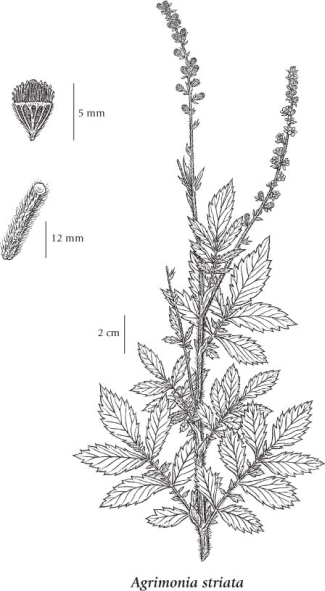Agrimonia striata Michx.
grooved agrimony (roadside agrimony)
Rosaceae (Rose family)
Introduction to Vascular Plants
grooved agrimony (roadside agrimony)
Rosaceae (Rose family)
Introduction to Vascular Plants
Species Information click to expand contents
General:
Perennial herb from a stout rhizome with fibrous roots; stems coarse, stiff, erect, 0.5-1 m tall, sometimes forked above, with both coarse and short, mostly spreading hairs.
Leaves:
Alternate, interruptedly odd-pinnately compound, the 5 to 11 main leaflets interspersed with much smaller ones; leaflets lanceolate to narrowly egg-shaped, 1-6 cm long, coarsely saw-toothed, long-tapering to sharp tip, dark green and somewhat spreading-hairy above, paler, veiny, soft-hairy and glandular-dotted beneath; stipules leaf-like, lance-egg-shaped, to 2 cm long.
Flowers:
Inflorescence a long, slender, terminal, spike-like raceme of several small, short-stalked flowers, the racemes 5-20 cm long, the axis without glands but with short, mostly ascending hairs; corollas yellow, saucer-shaped, the petals 5, about 3 mm long; calyces 5-lobed, the lobes lanceolate, spreading then converging after flowering and forming a beak on the fruit, the hypanthium conic, grooved, hooked-prickly; ovaries superior; stamens 5 to 15.
Fruits:
Achenes, 2, seed-like, enclosed within the enlarged hardened hypanthium, the hypanthium 10-grooved, minutely hairy in the grooves, glandular-dotted, with a crown of hooked bristles; entire bur-like fruit including the beak 4-5 mm long.
Illustration click to expand contents

If more than one illustration is available for a species (e.g., separate illustrations were provided for two subspecies) then links to the separate images will be provided below. Note that individual subspecies or varietal illustrations are not always available.
Illustration Source: The Illustrated Flora of British Columbia
USDA Species Characteristics click to expand contents
Flower Colour:
Yellow
Blooming Period:
Mid Summer
Fruit/Seed characteristics:
Colour: Brown
Present from Summer to Fall
Source: The USDA
Ecology click to expand contents
Ecological Framework for Agrimonia striata
The table below shows the species-specific information calculated from
original data (BEC database) provided by the BC Ministry of Forests and Range.
(Updated August, 2013)
The table below shows the species-specific information calculated from
original data (BEC database) provided by the BC Ministry of Forests and Range.
(Updated August, 2013)
| Site Information |
Value / Class |
||
|
Avg |
Min |
Max |
|
| Elevation
(metres) |
495 | 300 | 820 |
| Slope
Gradient (%) |
0 | 0 | 1 |
|
Aspect (degrees) |
0 | ||
| Soil
Moisture Regime (SMR) [0 - very xeric; 4 - mesic; 8 - hydric] |
5 | 5 | 7 |
| Modal
Nutrient Regime
Class |
D | ||
| #
of field plots species was recorded in: |
6 | ||
| Modal
BEC Zone Class |
ICH | ||
|
All BEC Zones (# of stations/zone) species was recorded in |
ICH(3), IDF(3) | ||
|
Source:
Klinkenberg 2013
|
|||
Habitat and Range click to expand contents
Mesic to moist meadows, thickets and open forests in the montane zone; infrequent in S BC east of the Coast-Cascade Mountains, disjunct in west-central BC (Hazelton area); E to NF and S to AZ, NE and WV.